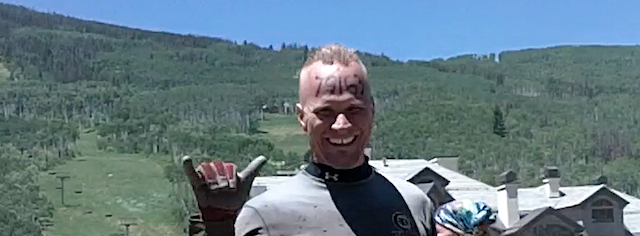Ten days ago at Raceway Park, New Jersey marked the World’s Toughest Mudder 2012. While our team qualified for the event by running the Beaver Creek Tough Mudder, we were unable to make it out to the east coast to face the World’s Toughest Mudder. But the event made me think back on how I learned to overcome obstacles by running the Tough Mudder.
Learning While Running the Beaver Creek Tough Mudder
The Tough Mudder is an obstacle event that consists of a running course that is typically between 10 to 12 miles long with more than 20 obstacles to overcome. Training and running the event is a physical and mental challenge. As a result I’ve washed off the layer of mud and returned to the workforce armed with new thoughts on overcoming obstacles. Here are 11 ways running the Tough Mudder helped me learn how to overcome obstacles:

Lesson #1 – TeamWork Matters
Working on a team can help you face obstacles better than going solo. Most of us know this from the workplace, but it is even more evident during the Tough Mudder.
Completing the Tough Mudder would be very difficult for most people to do without help. To face ice, water, mud, barbed wire, tunnels, 12 foot walls, and 10,000 volts of electricity takes teamwork. Over 90% of the participants in the Tough Mudder compete on a team. Your teammates push and prod both verbally and physically to help each other through the course.
On our team you could see how each person had strengths. Each of us had fears, but simple encouragement kept us going. We’d learn from each other how to face the obstacles and how to help each other overcome.
Off the course, life is no different. I’ve learned that I need to surround myself with a team that can help encourage, inspire, poke, and prod. I need a team that I can help out too. Teamwork goes both ways and more often I get more out of the team when I give more to my teammates.
Find and build your team, because teamwork matters.
Lesson #2 – Encourage Each Other
The second lesson I learned about overcoming obstacles while running the Tough Mudder was the importance of encouraging each other. I hate running. No seriously, I hate it. I even wrote an article on how I’m allergic to running. Sure I’ve found ways to make running a bit more bearable by making crazy combinations like Run-Pushup-Run.
But the Tough Mudder was different. This event was long distance. I’ve never had any desire to run a marathon, nor even a half marathon. But somehow the thought of running between obstacles made the Tough Mudder attractive. Even so, the distance had me concerned. How would I do attempting to run 12.2 miles? That was much further than the several 10k races I’ve run in the past.
That’s where I found that simple encouraging words help overcome obstacles. There were several times through the Tough Mudder where one, or all of us, would start to slow and long for a break or even a nap in the sun. At those times a simple word sparked new energy and drive. How are you doing? How’s that Tough Mudder?
For our team we had one team member who was a runner. He also didn’t have warm enough clothes, so he was constantly trying to warm up. That combination made him The Cardio-King and he kept our pace up so we would run instead of walk. Like clockwork, we’d emerge frozen from a cold-water obstacle to find him jumping up and down pleading for us to start running. We’d enter shade, he’d pick up the pace with yelps of encouragement to the team. Those words sparked us all on to run; even those like myself who hate running.
Truly the words themselves didn’t matter. What made a difference for me was someone noticing, sharing their energy, and encouraging us to continue.
When you face obstacles look around at others alongside and share a few simple words of encouragement. You will be surprised how those few words can ignite new reserves of energy.
Lesson #3 – Gear Matters
While my wife may say that my affinity to gear is just a side-effect of my obsessive compulsive disorder rearing its ugly head in fitness adventures, I disagree. Honestly, gear matters.
I’m a technologist at heart and enjoy researching new ideas. When I decided to take on the Tough Mudder it was no different – I asked “The Google” about the proper gear. I read, and read about other people’s experiences running the Tough Mudder. After way too many hours reading I settled in on three key things I needed to compete in the Tough Mudder:
- Shoes – Mudders For Your Feet
- Compression Shirt – Warmth For Your Core
- Gloves – Warmth and Grip For Your Mitts
Shoes were my primary concern. After extensive research online and after trying on just about any trail shoe I could get my hands on I focused in on the Inov-8 X-Talon 190. These shoes offered a few key characteristics that make them the ultimate Tough Mudder footwear: traction, lightweight, quick-draining upper. These shoes performed remarkably well. Not once did my feet feel soggy even going in and out of the muddy water. Not once did my feet slip; even when I tried to slip down one of the snow mounds. The X-Talon’s were like having off road mud tires for my feet. The only question I had from people, is Aren’t those cleats? Tough Mudder doesn’t allow cleats. While these shoes have tremendous amounts of traction, they are not cleats.
Running in Beaver Creek, Colorado means dealing with mountaintop weather. We ran on Sunday and the temperature was 30 degrees cooler than the day before where the high never broke 50 degrees Fahrenheit. The Tough Mudder course is filled with water and ice obstacles. So it was cold. But I wore an Under Armour Cold Weather gear compression shirt. It worked wonderfully by wicking away the sweat, but still keeping in the warmth. Perfect.
The last key piece of gear to run the Tough Mudder is gloves. I bought some Mad Gripz gloves because they had a sticky rubber on the fingers and palms while still having a fabric mesh back. I wanted some gloves that would keep me warm, yet still provide some level of grip when wet.
They worked great – except when I took them off. What? Yes, I took the gloves off for the first hanging obstacle. It was a mistake. The obstacle was the ring crossing. I should have known better, but …. enjoy my epic fall from the rings.
OCD aside, gear does matter. Now when I’m off the course I approach obstacles in life the same way. I research what tools would help accomplish the task better. Researching and finding the right tools can often make a difference between success and failure. Gear matters.
Lesson #4 – Train
Like any obstacle in life you also need to be prepared. Sure there are times when unexpected obstacles arise, but overall we all know the types of obstacles we can face in life. Train for them.
With the Tough Mudder is focused in on one aspect of training – recovery time. While I worked on training specifically for some of the obstacles, like the Monkey Bars, most of my training focused on building my cardiovascular system to perform well, then recover quickly. I counted on being able to recover as my body shifted from running to strength obstacles and back.
I dug deep into high intensity interval training using two main ingredients: kettlebells and Tabata intervals. Kettlebells could be described as a bowling ball with a handle. They can be used in dynamic exercises that offer both strength and cardiovascular training. Tabata intervals are a form of very high intensity training where the workout lasts only 4 minutes long and consists of 8 rounds of 20 second work periods followed by 10 seconds of rest.
While some may say that this doesn’t train you to cover long distances both my own experience and surrounding research would disagree. Training intervals prepares you to take on the long haul. I’ve pulled together ten of my favorite kettlebell interval workouts into a the 10 Kettlebell Tabatas program. They prepared me to not only finish, but finish in the top 5% of competitors which qualified our team to compete in the World’s Toughest Mudder.
How you train matters. Train in a way that prepares you for whatever obstacles can come your way.
lesson #5 – Distractions Can Be Helpful
Some of the obstacles I’ve faced in life seem to arise because I was the only one around. I became the primary focus. Some times we need some distractions around us.
One of the obstacles on the Tough Mudder drove this point home. The obstacle consisted of running up a muddy slope then face a ice-packed ramp at the top which was protected by a man armed with a firehouse. He would focus the stream of the firehouse at anyone attempting to climb up the last section of mud or on the ice. The water would knock people down, or make them lose their traction, or balance. Having him focus his attention on you was not good; you needed distractions around you.
By timing my ascent I was able to let him focus all of his water power on others. Is that selfish? Perhaps. But take those small opportunities when they arise; accept and watch for distractions around you when they will help you overcome obstacles.
Lesson #6 – Face Your Fears
I had one fear when researching the different obstacles on the Tough Mudder course – the boa constrictor. This obstacle required you to crawl through two segments of round tube. The center, between the two segments was in water over halfway up the tubes.
Even typing that very brief description caused my heart to start beating faster. This one just freaked me out. I am mildly claustrophobic. I think that’s what gets me on this one. I would continually think that I was going to get stuck in the tubes. Stuck in a dark wet tube unable to move forward, unable to back up.
But I faced my fears. Surprise – the fear was only in my head. I was able to crawl through the tubes and never even felt like I was close to getting stuck.
Too often I see the same problem with other obstacles in life. From afar the obstacle looks too frightening to even approach. From a distance I would get debilitated and not want to even try. But just like the boa constrictor on the Tough Mudder most of the time the fear is only in my head. Face your fears and conquer them.
Lesson #7 – It Only Looks Insurmountable
There were three sets of walls, Berlin Walls, that you had to get over. I’m not tall and these things looked completely insurmountable. But just like the boa constrictor I faced it and discovered that it wasn’t insurmountable.
The walls all have a small step ledge on the face. If you take a run, position your foot on the ledge and leap upwards the top is within reach.
Treat obstacles in life the same way. Watch for small footholds that can let you reach higher. Don’t let obstacles appear insurmountable, find ways to reach higher.
Lesson #8 – Go Further – One Step at a Time
Before competing in the Tough Mudder the furthest I had ever run was 8 miles. Oh and that was several decades in the past. I hate running. How was I going to cover the course spanning 12.2 miles. Yes, they changed the course just before the event; they had been saying the course was 10 miles long. When we arrived we found out it was going to be longer – 2.2 miles longer.
Well my training paid off, intervals work. But you can’t cover the miles without taking steps. Our team had one common theme – we kept going. We varied our pace, but we kept going. One step at a time.
Before we realized it we were approaching the finish line. I had run over 12.2 miles (with no muscle soreness either – yeah for kettlebell interval training!)
With every obstacle in life find ways to make progress even if that progress seems small. Take steps; keep taking steps. You will go further. Just don’t stop; keep moving and keep progressing.
Lesson #9 – Pain Is Worse In Your Head
10,000 volts!
I am trained as an electrical engineer. I’ve felt shocks from much less voltage and it hurt. Now I was willingly facing obstacles rigged with electric shock wires that would deliver 10,000 volts. What was I thinking?
Again this was all in my head. Of the different electrical shock obstacles only one hit me hard. We had to crawl along a wet layer of rubber immersed in 2″ of cold water while wires dangled just above us. If you come up off the surface — ZAP. I was fine once I was “in” the obstacle, but getting there was a shocking experience. The wires hit the back of my neck on both sides – bam. My muscles spasmed, but …. that was it.
Seriously, is that all you’ve got. It was less painful then some of the TENS (transcutaneous electrical nerve stimulation) I’ve received at physical therapists and chiropractors over the years.
Face it some obstacles appear to be painful. Face it head on and more often than not the pain you imaged was worse in your head. Typically we make obstacles and the pain associated with them worse then they are in reality. Don’t let that happen to you – bring it on.
Lesson #10 – Eyes On The Target – Not The Path
Imagine a 15 foot tall quarter-pipe of plastic coated with cooking oil and a little sand – that’s Mount Everest.
If you don’t reach the top – you will slide all the way back down. Remember this isn’t sliding on smooth fiber reinforced plastic – this is sand coated plastic. Think sandpaper.
I made it on the first shot. The key was focusing on the top not the path. To reach 15 feet up a quarter pipe you need to be able to sprint up and reach for the top to do a pull up to get over the top of the lip. Many people would run, but run forward instead of focusing on running up. That may sound like a subtle change, but after watching several people slide back down the pattern became evident. Those who watched where they were stepping, didn’t reach the top. Those who had their eyes high and focused on the top lip – reached the lip.
Do the same off the course. Don’t find yourself focusing in the minutia around you; keep the end-game in sight. Stay focused on your goals, on your purpose. By shifting your attention you will have a better probability of reaching it. Focus on your target; not the path.
Lesson #11 – Timing is Everything
The last obstacle of the Tough Mudder course is called Electro Shock Therapy. It is a muddy section roughly 20 feet wide and 50 feet long with 1000 wires hanging down from overhead. To make it more interesting several hay bales are littered through the course.
We determined that we would go through as a team. As we lined up to face the obstacle … providence appeared and a gust of wind came from behind. One of my teammates saw the opportunity and screamed “RUN”. We ran through while all 1,000 wires were blown clear by the wind. Shock-free.
Remember that when you face obstacles off the course. When circumstances change to your favor take charge and go. Timing is everything.
Run A Tough Mudder to Learn How To Overcome Obstacles
I loved running the Beaver Creek Tough Mudder. It was a feat to complete, better yet to complete fast enough to say we qualified to run in the World’s Toughest Mudder. But more than that the even helped me learn how to overcome obstacles in life while off the course.
Are you tough enough to be a Tough Mudder? Find a team, train hard, and see what you can learn about overcoming obstacles by running a Tough Mudder.
If you already have the cherished orange headband, then let’s hear your story on what the Tough Mudder taught you about overcoming obstacles.





Want to discuss? Join the conversation CubeDwellerFitness's Facebook Page.